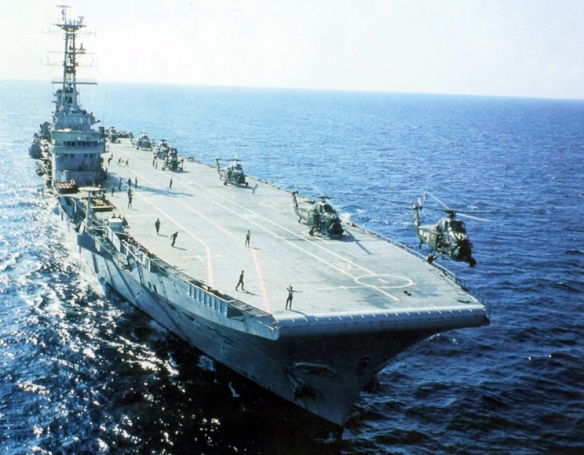The sixth HMS Bulwark of the Royal Navy was a 22,000 tonne Centaur-class light fleet aircraft carrier.
The Royal Navy was an early enthusiast of helicopter operation at sea and, as early as 1953, envisaged completely replacing fixed-wing antisubmarine warfare aircraft with large helicopters. It followed United States Marine Corps’s progress with helicopter assault landing experiments with keen interest. By 1955 the Royal Navy had employed light aircraft carriers as troop transports on a number of occasions and its chief of amphibious warfare, Major General C. F. Phillips, Royal Marines, requested development of both large and small troop carrying helicopters. The Admiralty responded by approving the start of work on designing a conversion of a light fleet carrier into an amphibious assault ship, termed a commando carrier in the Royal Navy, in July 1956.
Almost immediately, before work on a full-scale conversion had begun, the concept was tested in action. The British government decided to intervene in response to Egyptian Premier Gamal Abdul Nasser’s decision on July 26, 1956, to nationalize the Suez Canal. French and British officials drew up plans to launch a joint amphibious invasion to take over the Canal. As part of the invasion task force, two British light carriers, the Ocean and the Theseus, were hastily modified (in four days) to carry a full commando of 450 troops and twenty-two helicopters to transport them ashore. The mass helicopter assault concept was tested in a successful exercise just prior to their departure for Suez on October 12. Three weeks later the two carriers launched the first such assault against enemy opposition with complete success.
The success of the operation and the obvious utility of such techniques for imperial policing duties led to the permanent conversion of two later light carriers of the Centaur class, the Albion and the Bulwark, into commando carriers. They were stripped of most guns and fitted with accommodations for 900 troops. Sixteen helicopters provided troop lift, and four landing craft suspended from davits, transported heavy equipment ashore. Both ships were in service by 1962. A decade later their more modern semi-sister, the Hermes, was similarly converted when it was withdrawn from frontline carrier service as part of the run-down of Royal Navy fixed wing operation mandated by the 1966 Defence Review.
All the converted commando carriers were out of service by the early 1980s without direct replacements, although the support carriers of the Invincible class could readily convert to the commando role by embarking up to 1,000 troops and the assault helicopters to transport them. On September 1, 1993, however, the Royal Navy ordered a new helicopter assault ship, the Ocean, to compensate finally for the decommissioning of the dedicated commando carriers. The hull design was based on that of the Invincible class but the ship itself was constructed to Lloyd’s Register specifications for similar size merchant vessels except for those features specifically military in nature, a decision that substantially reduced the cost of construction. The Ocean is smaller and slower than its American contemporaries and, unlike them does not have a wet dock for launching its landing craft.
AMPHIBIOUS ASSAULT SHIP OPERATIONS
Although the United States Navy had conducted some experimental exercises earlier, the first use of helicopters from carriers to conduct an amphibious assault against opposition was by the Royal Navy at Suez in 1956. Two light carriers, the Ocean and the Theseus, were rapidly converted between September 25 and September 29 to accommodate a complete 450-man Royal Marine commando and to operate 22 helicopters, a joint force of Royal Navy, Royal Air Force, and Army machines, to land them. After validating the concept during a successful exercise in the United Kingdom, the two carriers joined the Anglo-French fleet assembled for the operation against Egyptian forces around the Suez Canal. On November 6, 1956, helicopters aboard the carriers landed all 450 troops from 45 Commandos in the city center of Port Said within ninety minutes. The commandos successfully linked up that afternoon with paratroops who had been dropped alongside the Suez Canal itself, consolidating their position there prior to the cease-fire that went into effect at midnight the same day.
The success of these extemporized assault carriers led to the Admiralty’s decision to undertake permanent conversions of two later light carriers, the Albion and the Bulwark, into commando carriers. Both ships operated extensively “east of Suez” in support of British efforts to hold on to its empire. The Bulwark formed part of the British force deployed to the Persian Gulf in a successful operation to deter an attempt by Iraq to invade Kuwait in the summer of 1961 (operation Vantage) then, together with its sister the Albion, participated in the extended British campaign confronting Indonesian efforts to take over Brunei and Borneo between late 1962 and 1966. The Albion also covered the British withdrawal from Aden in late 1967 while the Bulwark was deploying its commandos to prevent infiltration into eastern Malaysia. Britain’s withdrawal from its Far Eastern imperial holdings brought the two commando carriers back to European waters, where they engaged primarily in exercises to prepare for a potential conflict with the Soviet Union fought in the Norwegian littoral.
